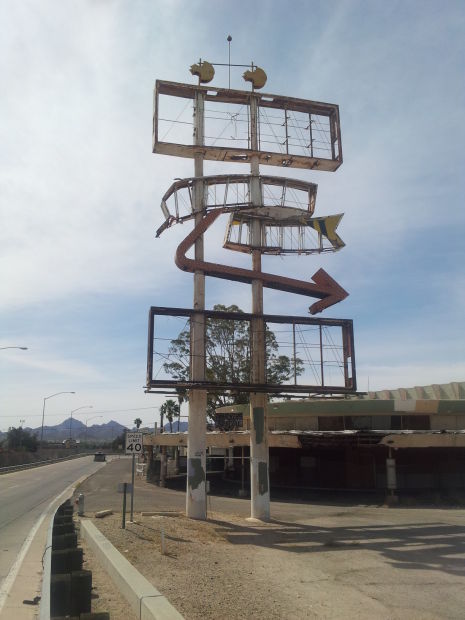What was an iconic Tucson sign has become an iconic eyesore.
The towering Spanish Trail Motel sign, on the north side of I-10 as it bends through South Tucson toward downtown, used to be a recognizable landmark for those coming into town from the east.
Now it’s a symbol of deterioration. All the plastic signage is gone, leaving a 70-or-so foot metal frame that seems to tell incoming travelers “This town is falling apart.”
Everyone can see it’s a problem, one piece of Tucson’s larger image problem, but tricky complications are keeping the natural thing from happening — tearing the frame down.
Part of the problem is that the sign is on a big deteriorating property in the city of South Tucson. There is a functional, 120-unit apartment complex, formerly Spanish Trail motel rooms, next to a bunch of boarded-up, falling apart buildings and former inn grounds. From a South Tucson perspective, the sign isn’t really the main problem — the whole property is.
In a revealing news story last May, KGUN 9 TV reported on the blighted property, going so far as to hire a helicopter to capture its true degree of collapse. I say “collapse” advisedly — some of the buildings’ roofs had actually fallen in. The property was also full of vehicles, appliances, construction materials and general junk.
After the story ran, South Tucson inspector Enrique Durazo went over to the property to give it a look over and later wrote up a citation due to the unsafe, unhealthy conditions there.
He never turned it in. Instead, he and new city manager Luis Gonzales sat down with the owners, Dennis and Rita Luttrell.
“We thought that maybe dialogue would be a good thing first,” Gonzales told me Friday in his city hall office. “He (Luttrell) allowed the inspector to go in and look around. Since that time, he’s actually been cleaning up.”
The Luttrells have removed trailers and most of the construction debris, as well as heating and cooling units, Durazo said.
So, from the South Tucson perspective, things are improving and could be moving toward the city’s eventual goal, the sale of the property and redevelopment of that whole area where South Fourth Avenue meets the freeway.
But they’re not focused on the problem from the freeway perspective, as passersby do. For others, the main problem, that towering symbol of deterioration, is being ignored.
It’s part of a broader image problem that the Tucson Metro Chamber of Commerce and others have tried to address, in the chamber’s case with its First Impressions program. That effort is to clean up the city’s sidewalks and medians in the area leading from the airport so that people arriving in Tucson see a more attractive place.
But that sort of effort won’t work with the Spanish Trail eyesore because it’s private property, said Mike Varney, president and CEO of the chamber.
“It’s flat-out ugly,” he said before wondering aloud whether the sign isn’t a health-and-safety violation of some sort.
Turns out, Durazo has looked into that, and the Luttrells have done enough work on the sign to prevent it from falling down or being a danger, so he can’t cite them for that, he said. But they’ve also got some estimates and found it would cost more than $100,000 to refurbish the sign. So it’s not going to be returned to its old glory any time soon.
“The sign needs to be restored. Whoever has the money to restore it, come on in,” Rita Luttrell told me Friday.
If the owners can’t afford restoring it, you would think the natural thing would be to to tear it down. But the Luttrells have an interest in keeping it up because it’s taller than current codes allow, so if it were torn down it couldn’t be rebuilt. Any future buyer of the property might consider the tall sign valuable.
Tearing it down, Rita Luttrell told me, “would be a big loss.”
Tearing it down, however, would not be a big cost. I asked Ruben Granados of Action Demolition, who is familiar with the sign, what he thought it would cost. Without visiting it, he said that, if no excavation is required, it should cost no more than $15,000 and possibly as little as $5,000.
“Knock down the whole damn thing is my opinion,” Granados said. “It’s an ugly sore on our city, and it’s a nice spot.”
Yes, there are historical considerations. The inn itself was once a nice place featuring music and dancing in its large round restaurant as well as pleasant grounds with an Olympic-size swimming pool. A 1984 Tucson Citizen story tells of Cleveland Indians players, mostly minor leaguers, who were staying at the inn during Spring Training. (Seventeen of them got food poisoning, hence the story.)
But that era is long gone, and the buildings are on their way, too. The sign itself is worth saving but probably too expensive, said Dirk Arnold, a Tucsonan who has been involved in saving the city’s historic signs and sells refrigerator magnets with their images.
“Someone should at the very least try to save the ‘Spanish Trail’ and the arrow,” Arnold said. “The big rectangular boxes were never terribly interesting.”
The plastic pieces themselves have either broken or been removed, but new ones could be made for reinstallation somewhere.
Of course, any consideration of the removal means first convincing either the Luttrells to do the right thing or the city of South Tucson to issue a citation and get the ball rolling toward condemnation.
South Tucson has long been a friendly, relaxed place, qualities I generally enjoy. But in this case the government’s friendliness is hurting the whole metro area by helping keep a prominent eyesore intact.
Now would be a good time for them to act stronger and for other players in the Tucson metro area to step in with money or ideas that can speed up improvements.





